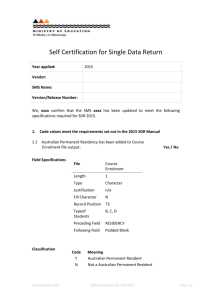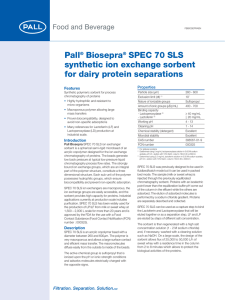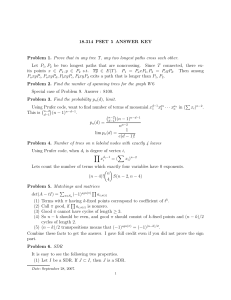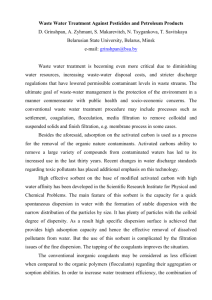SDR HyperD Solvent-Detergent Removal Sorbent ®
advertisement
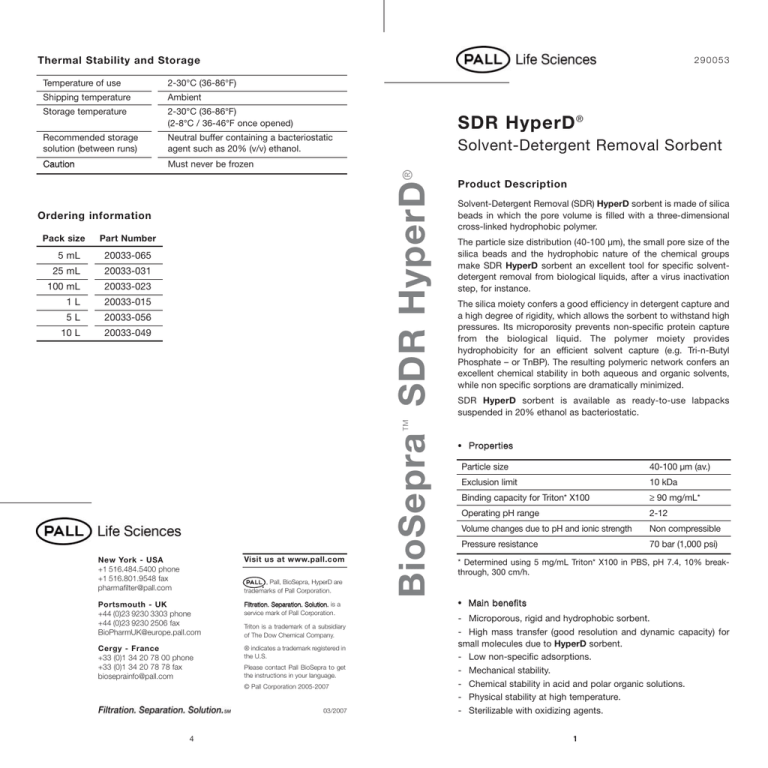
Thermal Stability and Storage 290053 2-30°C (36-86°F) Shipping temperature Ambient Storage temperature 2-30°C (36-86°F) (2-8°C / 36-46°F once opened) SDR HyperD ® Recommended storage solution (between runs) Neutral buffer containing a bacteriostatic agent such as 20% (v/v) ethanol. Solvent-Detergent Removal Sorbent Caution Must never be frozen Ordering information Pack size 5 mL Part Number 20033-065 20033-031 20033-023 1L 20033-015 5L 20033-056 10 L 20033-049 Product Description Solvent-Detergent Removal (SDR) HyperD sorbent is made of silica beads in which the pore volume is filled with a three-dimensional cross-linked hydrophobic polymer. The particle size distribution (40-100 μm), the small pore size of the silica beads and the hydrophobic nature of the chemical groups make SDR HyperD sorbent an excellent tool for specific solventdetergent removal from biological liquids, after a virus inactivation step, for instance. The silica moiety confers a good efficiency in detergent capture and a high degree of rigidity, which allows the sorbent to withstand high pressures. Its microporosity prevents non-specific protein capture from the biological liquid. The polymer moiety provides hydrophobicity for an efficient solvent capture (e.g. Tri-n-Butyl Phosphate – or TnBP). The resulting polymeric network confers an excellent chemical stability in both aqueous and organic solvents, while non specific sorptions are dramatically minimized. SDR HyperD sorbent is available as ready-to-use labpacks suspended in 20% ethanol as bacteriostatic. ™ 25 mL 100 mL BioSepra SDR HyperD ® Temperature of use New York - USA +1 516.484.5400 phone +1 516.801.9548 fax pharmafilter@pall.com Visit us at www.pall.com Portsmouth - UK +44 (0)23 9230 3303 phone +44 (0)23 9230 2506 fax BioPharmUK@europe.pall.com Filtration. Separation. Solution. is a service mark of Pall Corporation. Cergy - France +33 (0)1 34 20 78 00 phone +33 (0)1 34 20 78 78 fax bioseprainfo@pall.com ® indicates a trademark registered in the U.S. , Pall, BioSepra, HyperD are trademarks of Pall Corporation. Triton is a trademark of a subsidiary of The Dow Chemical Company. Please contact Pall BioSepra to get the instructions in your language. © Pall Corporation 2005-2007 03/2007 4 Properties Particle size 40-100 μm (av.) Exclusion limit 10 kDa Binding capacity for Triton* X100 90 mg/mL* Operating pH range 2-12 Volume changes due to pH and ionic strength Non compressible Pressure resistance 70 bar (1,000 psi) * Determined using 5 mg/mL Triton* X100 in PBS, pH 7.4, 10% breakthrough, 300 cm/h. Main benefits - Microporous, rigid and hydrophobic sorbent. - High mass transfer (good resolution and dynamic capacity) for small molecules due to HyperD sorbent. - Low non-specific adsorptions. - Mechanical stability. - Chemical stability in acid and polar organic solutions. - Physical stability at high temperature. - Sterilizable with oxidizing agents. 1 Chemical composition and structure Chemical stability SDR HyperD is a rigid sorbent in spherical bead form constituted of a network of silica and hydrophobic polymer. The particle size is 40100 μm. Porosity SDR HyperD sorbent has a microporous structure (10 KDa exclusion limit) and offers the following advantages : - Sieving phenomena avoiding non-specific trapping of proteins or others macromolecules. - High specific area (200 m2/g) providing high solvent-detergent dynamic capacity. Thermal stability Based on silica and chemically cross-linked polymer, SDR HyperD sorbent is stable over a wide range of temperatures. It can be autoclaved (20 min at 121°C / 250°F). Recommendations of use Column Capacity The solvent-detergent sorption capacity of SDR HyperD sorbent depends on : - The residence time of the sample on the column, - The flow rate, - The characteristics of the biological liquid. For a first use, a column length of 15 cm (5.9 in.) minimum and a working flow rate between 100 and 300 cm/h are recommended. Adsorption conditions - Equilibrate the column in PBS buffer using the working flow rate, until the pH, ionic strength and UV baselines are stable. Sorption capacities for bovine plasma are : - Inject 5 to 10 cv of the clean sample containing the solvent-mixture to be removed (e.g. 1% Triton* X100 and 0.5% TnBP) into the column, followed by the starting buffer. - Triton* X100: 60-80 mg/mL - TnBP: 40 to 50 mg/mL ™ BioSepra SDR HyperD ® The polymer is uniformly distributed in any empty space of the microporous silica skeleton, allowing the specific interaction of solvent-detergent with silanol and hydrophobic groups on the matrix contrary to proteins or any macromolecule for steric hindrance reasons. The polymer is highly cross-linked, to prevent any leakage during separation operation and cleaning steps. SDR HyperD sorbent is insoluble in water and in organic solvents. It is also very stable to strong denaturing agents, detergents, and chaotropic agents. Its stability in acidic aqueous solutions is exceptionally high. SDR HyperD packings can be washed repeatedly with 0.01 to 0.1 N hydrochloric acid or water-miscible organic solvent without undergoing substantial modification of the general properties of the matrix. This means that classical chemical treatments (except strong alkaline solution, for silica degradation reasons) for cleaning or pyrogen removal can be performed without changing the properties of SDR HyperD sorbent. For more drastic cleanings, see specific section below. Washing conditions Table 1: Solvent-Detergent Depletion Example Before depletion After depletion Removal efficiency IgG TnBP Triton* X100 5 mg/mL 10 mg/mL < 0.4 ppm < 10 ppm < 99.9% < 99.5% ATIII TnBP Triton* X100 5 mg/mL 10 mg/mL < 0.4 ppm < 10 ppm < 99.9% < 99.5% TnBP Triton* X100 5 mg/mL 10 mg/mL < 0.4 ppm < 10 ppm < 99.9% < 95.5% Bovine serum 290053 - 03/2007 Sample volume: 3.6 cv, Flow rate: 150 cm/h; Column length: 10 cm (3.9 in.); Residence time: 4 min. Mechanical stability The most commonly used procedure to desorb solvent-detergent molecules from the hydrophobic sorbent is to inject 1 cv of PBS / EtOH 95° (50/50) followed by 3 cv of EtOH 95°. If necessary, 2-isopropanol can also be used. According to the sample composition, 10 cv of PBS / EtOH 95° (50/50) can be used, followed by 10 cv of EtOH 95° and 10 cv of 2-isopropanol. Sanitization After packing and/or between runs, it may be necessary to sterilize and eliminate pyrogens from the column. This may be performed as follows : Method Procedure Alcohol/acid treatment Wash with at least 3 cv of a solution of 20% (v/v) ethanol containing 1 M acetic acid. This solution should be injected after removal of dissolved gas at a flow rate of 10-20 cm/h (1 hour contact time). After treatment, reequilibrate with normal sterile pyrogen-free buffer. SDR HyperD sorbent is non-compressible. For more information, please contact our technical service. 2 3

